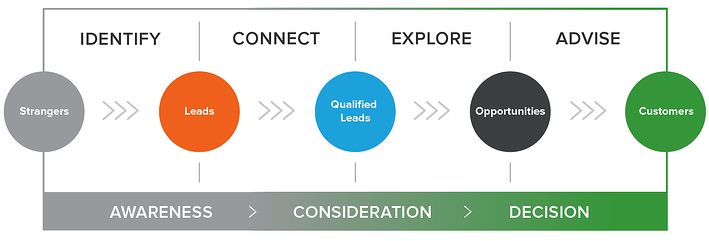Improve Your Customer Journey Map with Six Sigma
Have you ever heard of the concept of continuous improvement? We are talking about a work philosophy focused on a constant questioning of what could...
To convert any prospect from a lead to a customer, learn how to create a sales process for your team to use and drive sales effectively. In this article we will know the steps to create a sales process and the methodology for its application.
Table of Contents:
Related article: 4 Reasons why sales goals are not reached
First, we must know that the sales process is a series of steps that your company must carry out from the moment it captures the attention of a prospect, until there is a final transaction, or a product or service has been sold.
Within the Inbound Marketing methodology, this buying process is represented by means of a funnel, which shows the stage or category that represents the prospect, since not all of them become final buyers.
Next, we will see in detail the steps to follow to complete an effective sales process:
1. Identification of prospects: the search for new potential customers is vital for the beginning of the sales process. This research may involve investigating within social networks, conferences or industry events that help you to know the behaviors that these have and that they need so that you drive them to be interested in your product or service.
2. Qualification of prospects: Once the prospects are identified, the sales representative proceeds to collect information and profile them. In addition, she must qualify if the prospect will be a suitable potential customer for her business and if it is possible for him to advance adequately through the buyer's journey.
Article that may be of interest: Content ideas for each stage of the Customer Journey
3. Research: Once you know more about your prospects, you will know how to offer them a personalized experience and at the same time the probability of generating a sale. In this step, it is important to understand the behaviors, problems and needs that each prospect has and define how your product or service will help meet those needs.

4. Close sales: In this step of the process, it refers to any activity that helps you negotiate, such as the budget, proposal or aspect that helps clients make their final decision.
5. Continue selling: Part of the final process of a sale, is to continue offering the necessary information, that is, to continue communicating with customers after a sale. Following up on customers allows there to be a degree of loyalty from them to your brand and they continue to want your products or services.
Article of interest: Infographic: Data and Key Indicators regarding Loyalty issues
The first thing to keep in mind is that a sales methodology is not the same as a sales process, although they go hand in hand, the methodology establishes the foundations for your sales team to approach an effective sales process. Through this, you can streamline the customer journey and ensure that there are useful interactions between your sales team and customers.
Some of the most used methodologies in a sales process are the following:
1. Challenger sales methodology: the focus of this methodology is that salespeople learn about a client's business, adapt their sales techniques to their needs and weak points to offer everything the client needs.
2. Sellingsolutions: Sales reps focus solely on the customer's pain points, rather than just offering what they sell, more like offering a straightforward solution.
3. Sandler sales methodology: This type of methodology has both parties involved, both the buyer and the seller. For this to happen, the seller is highly qualified for any customer objection. However, it is the buyer who guides the buyer to finalize the purchase.
These types of new trends in the purchasing processes are what help buyers to take control in the sales process, so it is our task to continue in the constant study of the behavior, tastes and needs that are presented to them. to prospects or potential customers. That your sales representative does not lose direct interaction with their customers and guides them through the correct path with the appropriate methodology.
Article that may interest you: Digital capabilities improve sales team productivity.


Have you ever heard of the concept of continuous improvement? We are talking about a work philosophy focused on a constant questioning of what could...

When we are part of an organization, we find different areas, which will be composed of teams and systems that perform various tasks. This synergy...

Rarely was a successful effort in the sales team impromptu. Companies that achieve tangible results offer guidance to their salespeople, and those...